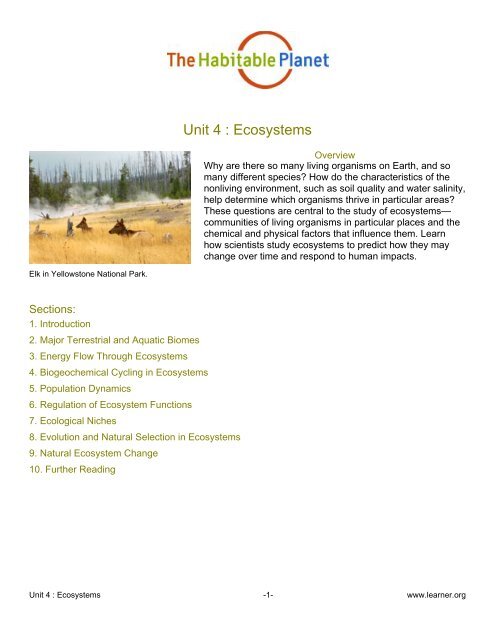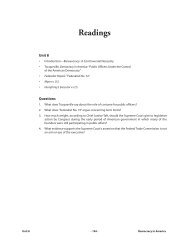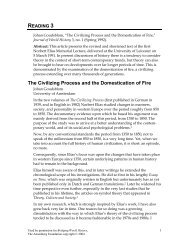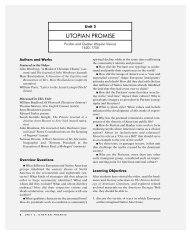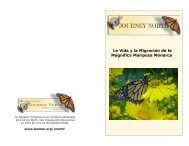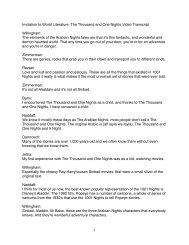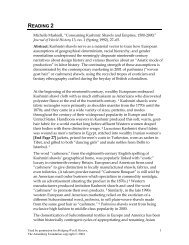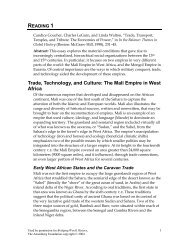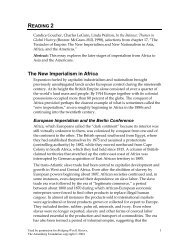Unit 4 : Ecosystems
Unit 4 : Ecosystems
Unit 4 : Ecosystems
Create successful ePaper yourself
Turn your PDF publications into a flip-book with our unique Google optimized e-Paper software.
<strong>Unit</strong> 4 : <strong>Ecosystems</strong><br />
Overview<br />
Why are there so many living organisms on Earth, and so<br />
many different species? How do the characteristics of the<br />
nonliving environment, such as soil quality and water salinity,<br />
help determine which organisms thrive in particular areas?<br />
These questions are central to the study of ecosystems—<br />
communities of living organisms in particular places and the<br />
chemical and physical factors that influence them. Learn<br />
how scientists study ecosystems to predict how they may<br />
change over time and respond to human impacts.<br />
Elk in Yellowstone National Park.<br />
Sections:<br />
1. Introduction<br />
2. Major Terrestrial and Aquatic Biomes<br />
3. Energy Flow Through <strong>Ecosystems</strong><br />
4. Biogeochemical Cycling in <strong>Ecosystems</strong><br />
5. Population Dynamics<br />
6. Regulation of Ecosystem Functions<br />
7. Ecological Niches<br />
8. Evolution and Natural Selection in <strong>Ecosystems</strong><br />
9. Natural Ecosystem Change<br />
10. Further Reading<br />
<strong>Unit</strong> 4 : <strong>Ecosystems</strong> -1- www.learner.org
1. Introduction<br />
Ecology is the scientific study of relationships in the natural world. It includes relationships between<br />
organisms and their physical environments (physiological ecology); between organisms of the same<br />
species (population ecology); between organisms of different species (community ecology); and<br />
between organisms and the fluxes of matter and energy through biological systems (ecosystem<br />
ecology).<br />
Ecologists study these interactions in order to understand the abundance and diversity of life within<br />
Earth's ecosystems—in other words, why there are so many plants and animals, and why there<br />
are so many different types of plants and animals (Fig. 1). To answer these questions they may<br />
use field measurements, such as counting and observing the behavior of species in their habitats;<br />
laboratory experiments that analyze processes such as predation rates in controlled settings; or field<br />
experiments, such as testing how plants grow in their natural setting but with different levels of light,<br />
water, and other inputs. Applied ecology uses information about these relationships to address issues<br />
such as developing effective vaccination strategies, managing fisheries without over-harvesting,<br />
designing land and marine conservation reserves for threatened species, and modeling how natural<br />
ecosystems may respond to global climate change.<br />
Figure 1. Tropical ecologist Stuart Davies in the field<br />
Change is a constant process in ecosystems, driven by natural forces that include climate shifts,<br />
species movement, and ecological succession. By learning how ecosystems function, we can<br />
improve our ability to predict how they will respond to changes in the environment. But since living<br />
<strong>Unit</strong> 4 : <strong>Ecosystems</strong> -2- www.learner.org
organisms in ecosystems are connected in complex relationships, it is not always easy to anticipate<br />
how a step such as introducing a new species will affect the rest of an ecosystem.<br />
Human actions are also becoming major drivers of ecosystem change. Important human-induced<br />
stresses on ecosystems are treated in later units of this text. Specifically, <strong>Unit</strong> 7 ("Agriculture")<br />
examines how agriculture and forestry create artificial, simplified ecosystems; <strong>Unit</strong> 9 ("Biodiversity<br />
Decline") discusses the effects of habitat loss and the spread of invasive species; and <strong>Unit</strong> 12<br />
("Earth's Changing Climate") considers how climate change is affecting natural ecosystems.<br />
2. Major Terrestrial and Aquatic Biomes<br />
Geography has a profound impact on ecosystems because global circulation patterns and climate<br />
zones set basic physical conditions for the organisms that inhabit a given area. The most important<br />
factors are temperature ranges, moisture availability, light, and nutrient availability, which together<br />
determine what types of life are most likely to flourish in specific regions and what environmental<br />
challenges they will face.<br />
As discussed in <strong>Unit</strong> 2, "Atmosphere," and <strong>Unit</strong> 3, "Oceans," Earth is divided into distinct climate<br />
zones that are created by global circulation patterns. The tropics are the warmest, wettest regions<br />
of the globe, while subtropical high-pressure zones create dry zones at about 30° latitude north and<br />
south. Temperatures and precipitation are lowest at the poles. These conditions create biomes—<br />
broad geographic zones whose plants and animals are adapted to different climate patterns. Since<br />
temperature and precipitation vary by latitude, Earth's major terrestrial biomes are broad zones that<br />
stretch around the globe (Fig. 2). Each biome contains many ecosystems (smaller communities)<br />
made up of organisms adapted for life in their specific settings.<br />
<strong>Unit</strong> 4 : <strong>Ecosystems</strong> -3- www.learner.org
Figure 2. Earth's major land biomes<br />
© <strong>Unit</strong>ed States Department of Agriculture.<br />
Another way to visualize major land biomes is to compare them based on their average temperature<br />
ranges and rainfall levels, which shows how these variables combine to create a range of climates<br />
(Fig. 3).<br />
<strong>Unit</strong> 4 : <strong>Ecosystems</strong> -4- www.learner.org
Figure 3. Biome type in relation to temperature and rainfall<br />
Land biomes are typically named for their characteristic types of vegetation, which in turn influence<br />
what kinds of animals will live there. Soil characteristics also vary from one biome to another,<br />
depending on local climate and geology. compares some key characteristics of three of the forest<br />
biomes.<br />
Table 1. Forest biomes.<br />
Forest type Temperature Precipitation Soil Flora<br />
Tropical 20-25°C >200 cm/yr Acidic, low in<br />
nutrients<br />
Temperate -30 to 30°C 75-150 cm/yr Fertile, high in<br />
nutrients<br />
Boreal (taiga) Very low 40-100 cm/year,<br />
mostly snow<br />
Thin, low in<br />
nutrients, acidic<br />
Diverse (up to 100<br />
species/km 2 )<br />
3-4 tree species/<br />
km 2<br />
Evergreens<br />
Aquatic biomes (marine and freshwater) cover three-quarters of the Earth's surface and include<br />
rivers, lakes, coral reefs, estuaries, and open ocean (Fig. 4). Oceans account for almost all of this<br />
area. Large bodies of water (oceans and lakes) are stratified into layers: surface waters are warmest<br />
and contain most of the available light, but depend on mixing to bring up nutrients from deeper levels<br />
<strong>Unit</strong> 4 : <strong>Ecosystems</strong> -5- www.learner.org
(for more details, see <strong>Unit</strong> 3, "Oceans"). The distribution of temperature, light, and nutrients set broad<br />
conditions for life in aquatic biomes in much the same way that climate and soils do for land biomes.<br />
Marine and freshwater biomes change daily or seasonally. For example, in the intertidal zone where<br />
the oceans and land meet, areas are submerged and exposed as the tide moves in and out. During<br />
the winter months lakes and ponds can freeze over, and wetlands that are covered with water in late<br />
winter and spring can dry out during the summer months.<br />
There are important differences between marine and freshwater biomes. The oceans occupy<br />
large continuous areas, while freshwater habitats vary in size from small ponds to lakes covering<br />
thousands of square kilometers. As a result, organisms that live in isolated and temporary freshwater<br />
environments must be adapted to a wide range of conditions and able to disperse between habitats<br />
when their conditions change or disappear.<br />
Figure 4. Earth's marine and freshwater biomes<br />
© <strong>Unit</strong>ed States Department of Agriculture.<br />
Since biomes represent consistent sets of conditions for life, they will support similar kinds of<br />
organisms wherever they exist, although the species in the communities in different places may not<br />
be taxonomically related. For example, large areas of Africa, Australia, South America, and India<br />
are covered by savannas (grasslands with scattered trees). The various grasses, shrubs, and trees<br />
that grow on savannas all are generally adapted to hot climates with distinct rainy and dry seasons<br />
and periodic fires, although they may also have characteristics that make them well-suited to specific<br />
conditions in the areas where they appear.<br />
<strong>Unit</strong> 4 : <strong>Ecosystems</strong> -6- www.learner.org
Species are not uniformly spread among Earth's biomes. Tropical areas generally have more plant<br />
and animal biodiversity than high latitudes, measured in species richness (the total number of species<br />
present) (footnote 1). This pattern, known as the latitudinal biodiversity gradient, exists in marine,<br />
freshwater, and terrestrial ecosystems in both hemispheres. Figure 5 shows the gradient for plant<br />
species, but it also holds true for animals.<br />
Figure 5. Plant species diversity<br />
Barthlott, W., Biedinger, N., Braun, G., Feig, F., Kier, G., and Mutke, J. (1999):<br />
Terminology and methodological aspects of the mapping and analysis of global diversity.<br />
Acta Botanica Fennica 162, 103–110.<br />
Why is biodiversity distributed in this way? Ecologists have proposed a number of explanations:<br />
• Higher productivity in the tropics allows for more species;<br />
• The tropics were not severely affected by glaciation and thus have had more time for<br />
species to develop and adapt;<br />
<strong>Unit</strong> 4 : <strong>Ecosystems</strong> -7- www.learner.org
• Environments are more stable and predictable in the tropics, with fairly constant<br />
temperatures and rainfall levels year-round;<br />
• More predators and pathogens limit competition in the tropics, which allows more species to<br />
coexist; and<br />
• Disturbances occur in the tropics at frequencies that promote high successional diversity.<br />
Of these hypotheses, evidence is strongest for the proposition that a stable, predictable environment<br />
over time tends to produce larger numbers of species. For example, both tropical ecosystems on land<br />
and deep sea marine ecosystems—which are subject to much less physical fluctuation than other<br />
marine ecosystems, such as estuaries—have high species diversity. Predators that seek out specific<br />
target species may also play a role in maintaining species richness in the tropics.<br />
3. Energy Flow Through <strong>Ecosystems</strong><br />
<strong>Ecosystems</strong> maintain themselves by cycling energy and nutrients obtained from external sources.<br />
At the first trophic level, primary producers (plants, algae, and some bacteria) use solar energy to<br />
produce organic plant material through photosynthesis. Herbivores—animals that feed solely on<br />
plants—make up the second trophic level. Predators that eat herbivores comprise the third trophic<br />
level; if larger predators are present, they represent still higher trophic levels. Organisms that feed<br />
at several trophic levels (for example, grizzly bears that eat berries and salmon) are classified at the<br />
highest of the trophic levels at which they feed. Decomposers, which include bacteria, fungi, molds,<br />
worms, and insects, break down wastes and dead organisms and return nutrients to the soil.<br />
On average about 10 percent of net energy production at one trophic level is passed on to the next<br />
level. Processes that reduce the energy transferred between trophic levels include respiration, growth<br />
and reproduction, defecation, and nonpredatory death (organisms that die but are not eaten by<br />
consumers). The nutritional quality of material that is consumed also influences how efficiently energy<br />
is transferred, because consumers can convert high-quality food sources into new living tissue more<br />
efficiently than low-quality food sources.<br />
The low rate of energy transfer between trophic levels makes decomposers generally more important<br />
than producers in terms of energy flow. Decomposers process large amounts of organic material<br />
and return nutrients to the ecosystem in inorganic form, which are then taken up again by primary<br />
producers. Energy is not recycled during decomposition, but rather is released, mostly as heat (this<br />
is what makes compost piles and fresh garden mulch warm). Figure 6 shows the flow of energy (dark<br />
arrows) and nutrients (light arrows) through ecosystems.<br />
<strong>Unit</strong> 4 : <strong>Ecosystems</strong> -8- www.learner.org
Figure 6. Energy and nutrient transfer through ecosystems<br />
© Ohio Environmental Protection Agency. Nature Connections.<br />
An ecosystem's gross primary productivity (GPP) is the total amount of organic matter that it<br />
produces through photosynthesis. Net primary productivity (NPP) describes the amount of energy<br />
that remains available for plant growth after subtracting the fraction that plants use for respiration.<br />
Productivity in land ecosystems generally rises with temperature up to about 30°C, after which it<br />
declines, and is positively correlated with moisture. On land primary productivity thus is highest in<br />
warm, wet zones in the tropics where tropical forest biomes are located. In contrast, desert scrub<br />
ecosystems have the lowest productivity because their climates are extremely hot and dry (Fig. 7).<br />
<strong>Unit</strong> 4 : <strong>Ecosystems</strong> -9- www.learner.org
Figure 7. Terrestrial net primary productivity<br />
© National Aeronautics and Space Administration.<br />
In the oceans, light and nutrients are important controlling factors for productivity. As noted in <strong>Unit</strong> 3,<br />
"Oceans," light penetrates only into the uppermost level of the oceans, so photosynthesis occurs in<br />
surface and near-surface waters. Marine primary productivity is high near coastlines and other areas<br />
where upwelling brings nutrients to the surface, promoting plankton blooms. Runoff from land is also<br />
a source of nutrients in estuaries and along the continental shelves. Among aquatic ecosystems,<br />
algal beds and coral reefs have the highest net primary production, while the lowest rates occur in the<br />
open due to a lack of nutrients in the illuminated surface layers (Fig. 8).<br />
<strong>Unit</strong> 4 : <strong>Ecosystems</strong> -10- www.learner.org
Figure 8. Ocean net primary productivity, 1997-2002<br />
© National Aeronautics and Space Administration.<br />
How many trophic levels can an ecosystem support? The answer depends on several factors,<br />
including the amount of energy entering the ecosystem, energy loss between trophic levels, and<br />
the form, structure, and physiology of organisms at each level. At higher trophic levels, predators<br />
generally are physically larger and are able to utilize a fraction of the energy that was produced at the<br />
level beneath them, so they have to forage over increasingly large areas to meet their caloric needs.<br />
Because of these energy losses, most terrestrial ecosystems have no more than five trophic levels,<br />
and marine ecosystems generally have no more than seven. This difference between terrestrial<br />
and marine ecosystems is likely due to differences in the fundamental characteristics of land and<br />
marine primary organisms. In marine ecosystems, microscopic phytoplankton carry out most of<br />
the photosynthesis that occurs, while plants do most of this work on land. Phytoplankton are small<br />
organisms with extremely simple structures, so most of their primary production is consumed and<br />
used for energy by grazing organisms that feed on them. In contrast, a large fraction of the biomass<br />
<strong>Unit</strong> 4 : <strong>Ecosystems</strong> -11- www.learner.org
that land plants produce, such as roots, trunks, and branches, cannot be used by herbivores for food,<br />
so proportionately less of the energy fixed through primary production travels up the food chain.<br />
Growth rates may also be a factor. Phytoplankton are extremely small but grow very rapidly, so they<br />
support large populations of herbivores even though there may be fewer algae than herbivores at<br />
any given moment. In contrast, land plants may take years to reach maturity, so an average carbon<br />
atom spends a longer residence time at the primary producer level on land than it does in a marine<br />
ecosystem. In addition, locomotion costs are generally higher for terrestrial organisms compared to<br />
those in aquatic environments.<br />
The simplest way to describe the flux of energy through ecosystems is as a food chain in which<br />
energy passes from one trophic level to the next, without factoring in more complex relationships<br />
between individual species. Some very simple ecosystems may consist of a food chain with<br />
only a few trophic levels. For example, the ecosystem of the remote wind-swept Taylor Valley in<br />
Antarctica consists mainly of bacteria and algae that are eaten by nematode worms (footnote 2).<br />
More commonly, however, producers and consumers are connected in intricate food webs with some<br />
consumers feeding at several trophic levels (Fig. 9).<br />
Figure 9. Lake Michigan food web<br />
Courtesy of NOAA Great Lakes Environmental Research Laboratory and the Great<br />
Lakes Fishery Commission.<br />
<strong>Unit</strong> 4 : <strong>Ecosystems</strong> -12- www.learner.org
An important consequence of the loss of energy between trophic levels is that contaminants collect<br />
in animal tissues—a process called bioaccumulation. As contaminants bioaccumulate up the food<br />
web, organisms at higher trophic levels can be threatened even if the pollutant is introduced to the<br />
environment in very small quantities.<br />
The insecticide DDT, which was widely used in the <strong>Unit</strong>ed States from the 1940s through the 1960s,<br />
is a famous case of bioaccumulation. DDT built up in eagles and other raptors to levels high enough<br />
to affect their reproduction, causing the birds to lay thin-shelled eggs that broke in their nests.<br />
Fortunately, populations have rebounded over several decades since the pesticide was banned in the<br />
<strong>Unit</strong>ed States. However, problems persist in some developing countries where toxic bioaccumulating<br />
pesticides are still used.<br />
Bioaccumulation can threaten humans as well as animals. For example, in the <strong>Unit</strong>ed States<br />
many federal and state agencies currently warn consumers to avoid or limit their consumption of<br />
large predatory fish that contain high levels of mercury, such as shark, swordfish, tilefish, and king<br />
mackerel, to avoid risking neurological damage and birth defects.<br />
4. Biogeochemical Cycling in <strong>Ecosystems</strong><br />
Along with energy, water and several other chemical elements cycle through ecosystems and<br />
influence the rates at which organisms grow and reproduce. About 10 major nutrients and six trace<br />
nutrients are essential to all animals and plants, while others play important roles for selected species<br />
(footnote 3). The most important biogeochemical cycles affecting ecosystem health are the water,<br />
carbon, nitrogen, and phosphorus cycles.<br />
As noted earlier, most of the Earth's area that is covered by water is ocean. In terms of volume, the<br />
oceans dominate further still: nearly all of Earth's water inventory is contained in the oceans (about<br />
97 percent) or in ice caps and glaciers (about 2 percent), with the rest divided among groundwater,<br />
lakes, rivers, streams, soils, and the atmosphere. In addition, water moves very quickly through land<br />
ecosystems. These two factors mean that water's residence time in land ecosystems is generally<br />
short, on average one or two months as soil moisture, weeks or months in shallow groundwater, or up<br />
to six months as snow cover.<br />
But land ecosystems process a lot of water: almost two-thirds of the water that falls on land as<br />
precipitation annually is transpired back into the atmosphere by plants, with the rest flowing into rivers<br />
and then to the oceans. Because cycling of water is central to the functioning of land ecosystems,<br />
changes that affect the hydrologic cycle are likely to have significant impacts on land ecosystems.<br />
(Global water cycling is discussed in more detail in <strong>Unit</strong> 8, "Water Resources.")<br />
Both land and ocean ecosystems are important sinks for carbon, which is taken up by plants and<br />
algae during photosynthesis and fixed as plant tissue. Table 2 compares the quantities of carbon<br />
stored in Earth's major reservoirs.<br />
<strong>Unit</strong> 4 : <strong>Ecosystems</strong> -13- www.learner.org
Table 2. Global carbon storage.<br />
Location<br />
Atmosphere 750<br />
Land plants 610<br />
Soil and detritus 1,500<br />
Surface ocean 1,020<br />
Intermediate and deep ocean 37,890<br />
Sediments 78,000,000<br />
Amount (gigatons carbon)<br />
Carbon cycles relatively quickly through land and surface-ocean ecosystems, but may remain locked<br />
up in the deep oceans or in sediments for thousands of years. The average residence time that a<br />
molecule of carbon spends in a terrestrial ecosystem is about 17.5 years, although this varies widely<br />
depending on the type of ecosystem: carbon can be held in old-growth forests for hundreds of years,<br />
but its residence time in heavily grazed ecosystems where plants and soils are repeatedly turned over<br />
may be as short as a few months.<br />
Human activities, particularly fossil fuel combustion, emit significant amounts of carbon each year<br />
over and above the natural carbon cycle. Currently, human activities generate about 7 billion tons of<br />
carbon per year, of which 3 billion tons remain in the atmosphere. The balance is taken up in roughly<br />
equal proportions by oceans and land ecosystems. Identifying which ecosystems are absorbing this<br />
extra carbon and why this uptake is occurring are pressing questions for ecologists.<br />
Currently, it is not clear what mechanisms are responsible for high absorption of carbon by land<br />
ecosystems. One hypothesis suggests that higher atmospheric CO 2 concentrations have increased<br />
the rates at which plants carry out photosynthesis (so-called CO2 fertilization), but this idea is<br />
controversial. Controlled experiments have shown that elevated CO 2 levels are only likely to produce<br />
short-term increases in plant growth, because plants soon exhaust available supplies of important<br />
nutrients such as nitrogen and phosphorus that also are essential for growth.<br />
Nitrogen and phosphorus are two of the most essential mineral nutrients for all types of ecosystems<br />
and often limit growth if they are not available in sufficient quantities. (This is why the basic<br />
ingredients in plant fertilizer are nitrogen, phosphorus, and potassium, commonly abbreviated as<br />
NPK.) A slightly expanded version of the basic equation for photosynthesis shows how plants use<br />
energy from the sun to turn nutrients and carbon into organic compounds:<br />
CO 2 + PO 4 (phosphate) + NO 3 (nitrate) + H 2 O → CH 2 O, P, N (organic tissue) + O 2<br />
Because atmospheric nitrogen (N 2 ) is inert and cannot be used directly by most organisms,<br />
microorganisms that convert it into usable forms of nitrogen play central roles in the nitrogen cycle.<br />
So-called nitrogen-fixing bacteria and algae convert ammonia (NH 4 ) in soils and surface waters into<br />
<strong>Unit</strong> 4 : <strong>Ecosystems</strong> -14- www.learner.org
nitrites (NO 2 ) and nitrates (NO 3 ), which in turn are taken up by plants. Some of these bacteria live in<br />
mutualistic relationships on the roots of plants, mainly legumes (peas and beans), and provide nitrate<br />
directly to the plants; farmers often plant these crops to restore nitrogen to depleted soils. At the back<br />
end of the cycle, decomposers break down dead organisms and wastes, converting organic materials<br />
to inorganic nutrients. Other bacteria carry out denitrification, breaking down nitrate to gain oxygen<br />
and returning gaseous nitrogen to the atmosphere (Fig. 10).<br />
Figure 10. The nitrogen cycle<br />
© U.S. Department of the Interior, National Park Service.<br />
Human activities, including fossil fuel combustion, cultivation of nitrogen-fixing crops, and rising use<br />
of nitrogen fertilizer, are altering the natural nitrogen cycle. Together these activities add roughly as<br />
much nitrogen to terrestrial ecosystems each year as the amount fixed by natural processes; in other<br />
words, anthropogenic inputs are doubling annual nitrogen fixation in land ecosystems. The main<br />
effect of this extra nitrogen is over-fertilization of aquatic ecosystems. Excess nitrogen promotes algal<br />
blooms, which then deplete oxygen from the water when the algae die and decompose (for more<br />
details, see <strong>Unit</strong> 8, "Water Resources"). Additionally, airborne nitrogen emissions from fossil fuel<br />
combustion promote the formation of ground-level ozone, particulate emissions, and acid rain (for<br />
more details, see <strong>Unit</strong> 11, "Atmospheric Pollution").<br />
Phosphorus, the other major plant nutrient, does not have a gaseous phase like carbon or nitrogen.<br />
As a result it cycles more slowly through the biosphere. Most phosphorus in soils occurs in forms<br />
that organisms cannot use directly, such as calcium and iron phosphate. Usable forms (mainly<br />
<strong>Unit</strong> 4 : <strong>Ecosystems</strong> -15- www.learner.org
orthophosphate, or PO 4 ) are produced mainly by decomposition of organic material, with a small<br />
contribution from weathering of rocks (Fig. 11).<br />
Figure 11. The phosphorus cycle<br />
© <strong>Unit</strong>ed States Environmental Protection Agency.<br />
The amount of phosphate available to plants depends on soil pH. At low pH, phosphorus binds<br />
tightly to clay particles and is transformed into relatively insoluble forms containing iron and<br />
aluminum. At high pH, it is lost to other inaccessible forms containing calcium. As a result, the highest<br />
concentrations of available phosphate occur at soil pH values between 6 and 7. Thus soil pH is an<br />
important factor affecting soil fertility.<br />
Excessive phosphorus can also contribute to over-fertilization and eutrophication of rivers and lakes.<br />
Human activities that increase phosphorus concentrations in natural ecosystems include fertilizer use,<br />
discharges from wastewater treatment plants, and use of phosphate detergents (for details, see <strong>Unit</strong><br />
8, "Water Resources").<br />
5. Population Dynamics<br />
Every organism in an ecosystem divides its energy among three competing goals: growing, surviving,<br />
and reproducing. Ecologists refer to an organism's allocation of energy among these three ends<br />
throughout its lifetime as its life history strategy. There are tradeoffs between these functions: for<br />
<strong>Unit</strong> 4 : <strong>Ecosystems</strong> -16- www.learner.org
example, an organism that spends much of its energy on reproduction early in life will have lower<br />
growth and survival rates, and thus a lower reproductive level later in life. An optimal life history<br />
strategy maximizes the organism's contribution to population growth.<br />
Understanding how the environment shapes organisms' life histories is a major question in ecology.<br />
Compare the conditions for survival in an unstable area, such as a flood plain near a river that<br />
frequently overflows its banks, to those in a stable environment, such as a remote old-growth forest.<br />
On the flood plain, there is a higher chance of being killed early in life, so the organisms that mature<br />
and reproduce earlier will be most likely to survive and add to population growth. Producing many<br />
offspring increases the chance that some will survive. Conversely, organisms in the forest will mature<br />
later and have lower early reproductive rates. This allows them to put more energy into growth and<br />
competition for resources.<br />
Ecologists refer to organisms at the first of these two extremes (those adapted to unstable<br />
environments) as r-selected. These organisms live in settings where population levels are well below<br />
the maximum number that the environment can support—the carrying capacity—so their numbers are<br />
growing exponentially at the maximum rate at which that population can increase if resources are not<br />
limited (often abbreviated as r). The other extreme, organisms adapted to stable environments, are<br />
termed K-selected because they live in environments in which the number of individuals is at or near<br />
the environment's carrying capacity (often abbreviated as K).<br />
Organisms that are r-selected tend to be small, short-lived, and opportunistic, and to grow through<br />
irregular boom-and-bust population cycles. They include many insects, annual plants, bacteria, and<br />
larger species such as frogs and rats. Species considered pests typically are r-selected organisms<br />
that are capable of rapid growth when environmental conditions are favorable. In contrast, K-selected<br />
species are typically larger, grow more slowly, have fewer offspring and spend more time parenting<br />
them. Examples include large mammals, birds, and long-lived plants such as redwood trees. K-<br />
selected species are more prone to extinction than r-selected species because they mature later<br />
in life and have fewer offspring with longer gestation times. Table 3 contrasts the reproductive<br />
characteristics of an r-selected mammal, the Norway rat, to those of a K-selected mammal, the<br />
African elephant.<br />
Table 3. Reproduction in r-selected and K-selected species.<br />
Feature Norway rat (r-selected) African elephant (K-selected)<br />
Reaches sexual or reproductive<br />
maturity<br />
3-4 months 10-12 years<br />
Average gestation period 22-24 days 22 months<br />
Time to weaning 3-4 weeks 48-108 months<br />
Breeding interval (female) Up to 7 times per year Every 4 to 9 years<br />
<strong>Unit</strong> 4 : <strong>Ecosystems</strong> -17- www.learner.org
Feature Norway rat (r-selected) African elephant (K-selected)<br />
Offspring per litter 2-14 (average 8) 1 average, 2 high<br />
Many organisms fall between these two extremes and have some characteristics of both types. As we<br />
will see below, ecosystems tend to be dominated by r-selected species in their early stages with the<br />
balance gradually shifting toward K-selected species.<br />
In a growing population, survival and reproduction rates will not stay constant over time. Eventually<br />
resource limitations will reduce one or both of these variables. Populations grow fastest when they<br />
are near zero and the species is uncrowded. A simple mathematical model of population growth<br />
implies that the maximum population growth rate occurs when the population size (N) is at one-half of<br />
the environment's carrying capacity, K (i.e., at N = K/2).<br />
In theory, if a population is harvested at exactly its natural rate of growth, the population will not<br />
change in size, and the harvest (yield) can be sustained at that level. In practice, however, it can be<br />
very hard to estimate population sizes and growth rates in the wild accurately enough to achieve this<br />
maximum sustainable yield. (For more on over-harvesting, see <strong>Unit</strong> 9, "Biodiversity Decline.")<br />
6. Regulation of Ecosystem Functions<br />
A key question for ecologists studying growth and productivity in ecosystems is which factors limit<br />
ecosystem activity. Availability of resources, such as light, water, and nutrients, is a key control<br />
on growth and reproduction. Some nutrients are used in specific ratios. For example, the ratio of<br />
nitrogen to phosphorus in the organic tissues of algae is about 16 to 1, so if the available nitrogen<br />
concentration is greater than 16 times the phosphorus concentration, then phosphorus will be the<br />
factor that limits growth; if it is less, then nitrogen will be limiting. To understand how a specific<br />
ecosystem functions, it thus is important to identify what factors limit ecosystem activity.<br />
Resources influence ecosystem activity differently depending on whether they are essential,<br />
substitutable, or complementary. Essential resources limit growth independently of other levels: if<br />
the minimum quantity needed for growth is not available, then growth does not occur. In contrast,<br />
if two resources are substitutable, then population growth is limited by an appropriately weighted<br />
sum of the two resources in the environment. For example, glucose and fructose are substitutable<br />
food sources for many types of bacteria. Resources may also be complementary, which means that<br />
a small amount of one resource can substitute for a relatively large amount of another, or can be<br />
complementary over a specific range of conditions.<br />
Resource availability serves as a so-called "bottom-up" control on an ecosystem: the supply of<br />
energy and nutrients influences ecosystem activities at higher trophic levels by affecting the amount<br />
of energy that moves up the food chain. In some cases, ecosystems may be more strongly influenced<br />
by so-called "top-down" controls—namely, the abundance of organisms at high trophic levels in<br />
the ecosystem (Fig. 12). Both types of effects can be at work in an ecosystem at the same time,<br />
<strong>Unit</strong> 4 : <strong>Ecosystems</strong> -18- www.learner.org
ut how far bottom-up effects extend in the food web, and the extent to which the effects of trophic<br />
interactions at the top of the food web are felt through lower levels, vary over space and time and with<br />
the structure of the ecosystem.<br />
Figure 12. Predators impose top-down control on ecosystems<br />
Many ecological studies seek to measure whether bottom-up or top-down controls are more important<br />
in specific ecosystems because the answers can influence conservation and environmental protection<br />
strategies. For example, a study by Benjamin S. Halpern and others of food web controls in kelp<br />
forest ecosystems off the coast of Southern California found that variations in predator abundance<br />
explained a significant proportion of variations in the abundance of algae and the organisms at<br />
higher trophic levels that fed on algae and plankton. In contrast, they found no significant relationship<br />
between primary production by algae and species abundance at higher trophic levels. The most<br />
influential predators included spiny lobster, Kellet's whelk, rockfish, and sea perch. Based on these<br />
findings, the authors concluded that "[e]fforts to control activities that affect higher trophic levels (such<br />
as fishing) will have far larger impacts on community dynamics than efforts to control, for example,<br />
nutrient input, except when these inputs are so great as to create anoxic (dead) zones" (footnote 4).<br />
Drastic changes at the top of the food web can trigger trophic cascades, or domino effects that are<br />
felt through many lower trophic levels. The likelihood of a trophic cascade depends on the number of<br />
trophic levels in the ecosystem and the extent to which predators reduce the abundance of a trophic<br />
level to below their resource-limited carrying capacity. Some species are so important to an entire<br />
ecosystem that they are referred to as keystone species, connoting that they occupy an ecological<br />
<strong>Unit</strong> 4 : <strong>Ecosystems</strong> -19- www.learner.org
niche that influences many other species. Removing or seriously impacting a keystone species<br />
produces major impacts throughout the ecosystem.<br />
Many scientists believe that the reintroduction of wolves into Yellowstone National Park in 1995,<br />
after they had been eradicated from the park for decades through hunting, has caused a trophic<br />
cascade with results that are generally positive for the ecosystem. Wolves have sharply reduced the<br />
population of elk, allowing willows to grow back in many riparian areas where the elk had grazed the<br />
willows heavily. Healthier willows are attracting birds and small mammals in large numbers.<br />
"Species, like riparian songbirds, insects, and in particular, rodents, have come back into these<br />
preferred habitat types, and other species are starting to respond," says biologist Robert Crabtree of<br />
the Yellowstone Ecological Research Center. "For example, fox and coyotes are moving into these<br />
areas because there's more prey for them. There's been an erupting trophic cascade in some of<br />
these lush riparian habitat sites."<br />
7. Ecological Niches<br />
Within ecosystems, different species interact in different ways. These interactions can have positive,<br />
negative, or neutral impacts on the species involved (Table 4).<br />
Table 4. Relationships between individuals of different species.<br />
Type of interaction Effect of interaction Examples<br />
Competition<br />
Predation Parasitism<br />
Mutualism<br />
Commensalism<br />
Both species are harmed<br />
(population growth rates are<br />
reduced).<br />
One species benefits, one is<br />
harmed.<br />
Both species benefit.<br />
Relationship may not be<br />
essential for either.<br />
One species benefits, one is not<br />
affected.<br />
Oak trees and maple trees<br />
competing for light in a forest,<br />
wading birds foraging for food in<br />
a marsh<br />
Predation: wolf and<br />
rabbitParasitism: flea and wolf<br />
Humans and house pets, insect<br />
pollination of flowers<br />
Maggots decomposing a rotting<br />
carcass<br />
<strong>Unit</strong> 4 : <strong>Ecosystems</strong> -20- www.learner.org
Amensalism<br />
Type of interaction Effect of interaction Examples<br />
One species harms another<br />
(typically by releasing a toxic<br />
substance), but is not affected<br />
itself.<br />
Allelopathy (plants that<br />
produce substances harmful<br />
to other plants): rye and wheat<br />
suppress weeds when used as<br />
cover crops, broccoli residue<br />
suppresses growth of other<br />
vegetables in the same plant<br />
family<br />
Each species in an ecosystem occupies a niche, which comprises the sum total of its relationships<br />
with the biotic and abiotic elements of its environment—more simply, what it needs to survive. In<br />
a 1957 address, zoologist George Evelyn Hutchinson framed the view that most ecologists use<br />
today when he defined the niche as the intersection of all of the ranges of tolerance under which an<br />
organism can live (footnote 5). This approach makes ecological niches easier to quantify and analyze<br />
because they can be described as specific ranges of variables like temperature, latitude, and altitude.<br />
For example, the African Fish Eagle occupies a very similar ecological niche to the American Bald<br />
Eagle (Fig. 13). In practice it is hard to measure all of the variables that a species needs to survive,<br />
so descriptions of an organism's niche tend to focus on the most important limiting factors.<br />
Figure 13. African fish eagle<br />
Courtesy Wikimedia Commons. Public domain.<br />
<strong>Unit</strong> 4 : <strong>Ecosystems</strong> -21- www.learner.org
The full range of habitat types in which a species can exist and reproduce without any competition<br />
from other species is called its fundamental niche. The presence of other species means that few<br />
species live in such conditions. A species' realized niche can be thought of as its niche in practice<br />
—the range of habitat types from which it is not excluded by competing species. Realized niches<br />
are usually smaller than fundamental niches, since competitive interactions exclude species from at<br />
least some conditions under which they would otherwise grow. Species may occupy different realized<br />
niches in various locations if some constraint, such as a certain predator, is present in one area but<br />
not in another.<br />
In a classic set of laboratory experiments, Russian biologist G.F. Gause showed the difference<br />
between fundamental and realized niches. Gause compared how two strains of Paramecium grew<br />
when they were cultured separately in the same type of medium to their growth rates when cultured<br />
together. When cultured separately both strains reproduced rapidly, which indicated that they were<br />
adapted to living and reproducing under the same conditions. But when they were cultured together,<br />
one strain out-competed and eventually eliminated the other. From this work Gause developed a<br />
fundamental concept in community ecology: the competitive exclusion principle, which states that if<br />
two competitors try to occupy the same realized niche, one species will eliminate the other (footnote<br />
6).<br />
Many key questions about how species function in ecosystems can be answered by looking at their<br />
niches. Species with narrow niches tend to be specialists, relying on comparatively few food sources.<br />
As a result, they are highly sensitive to changes in key environmental conditions, such as water<br />
temperature in aquatic ecosystems. For example, pandas, which only eat bamboo, have a highly<br />
specialized diet. Many endangered species are threatened because they live or forage in particular<br />
habitats that have been lost or converted to other uses. One well-known case, the northern spotted<br />
owl lives in cavities of trees in old-growth forests (forests with trees that are more than 200 years old<br />
and have not been cut, pruned, or managed), but these forests have been heavily logged, reducing<br />
the owl's habitat.<br />
In contrast, species with broad niches are generalists that can adapt to wider ranges of environmental<br />
conditions within their own lifetimes (i.e., not through evolution over generations, but rather through<br />
changes in their behavior or physiologic functioning) and survive on diverse types of prey. Coyotes<br />
once were found only on the Great Plains and in the western <strong>Unit</strong>ed States, but have spread through<br />
the eastern states in part because of their flexible lifestyle. They can kill and eat large, medium, or<br />
small prey, from deer to house cats, as well as other foods such as invertebrates and fruit, and can<br />
live in a range of habitats, from forests to open landscapes, farmland, and suburban neighborhoods<br />
(footnote 7).<br />
Overlap between the niches of two species (more precisely, overlap between their resource use<br />
curves) causes the species to compete if resources are limited. One might expect to see species<br />
constantly dying off as a result, but in many cases competing species can coexist without either being<br />
eliminated. This happens through niche partitioning (also referred to as resource partitioning), in<br />
which two species divide a limiting resource such as light, food supply, or habitat.<br />
<strong>Unit</strong> 4 : <strong>Ecosystems</strong> -22- www.learner.org
8. Evolution and Natural Selection in <strong>Ecosystems</strong><br />
As species interact, their relationships with competitors, predators, and prey contribute to natural<br />
selection and thus influence their evolution over many generations. To illustrate this concept, consider<br />
how evolution has influenced the factors that affect the foraging efficiency of predators. This includes<br />
the predator's search time (how long it takes to find prey), its handling time (how hard it has to work<br />
to catch and kill it), and its prey profitability (the ratio of energy gained to energy spent handling<br />
prey). Characteristics that help predators to find, catch, and kill prey will enhance their chances of<br />
surviving and reproducing. Similarly, prey will profit from attributes that help avoid detection and make<br />
organisms harder to handle or less biologically profitable to eat.<br />
These common goals drive natural selection for a wide range of traits and behaviors, including:<br />
• Mimicry by either predators or prey. A predator such as a praying mantis that blends in with<br />
surrounding plants is better able to surprise its target. However, many prey species also<br />
engage in mimicry, developing markings similar to those of unpalatable species so that<br />
predators avoid them. For example, harmless viceroy butterflies have similar coloration<br />
to monarch butterflies, which store toxins in their tissues, so predators avoid viceroy<br />
butterflies.<br />
• Optimal foraging strategies enable predators to obtain a maximum amount of net energy<br />
per unit of time spent foraging. Predators are more likely to survive and reproduce if they<br />
restrict their diets to prey that provide the most energy per unit of handling time and focus<br />
on areas that are rich with prey or that are close together. The Ideal Free Distribution model<br />
suggests that organisms that are able to move will distribute themselves according to the<br />
amount of food available, with higher concentrations of organisms located near higher<br />
concentrations of food . Many exceptions have been documented, but this theory is a good<br />
general predictor of animal behavior.<br />
• Avoidance/escape features help prey elude predators. These attributes may be behavioral<br />
patterns, such as animal herding or fish schooling to make individual organisms harder to<br />
pick out. Markings can confuse and disorient predators: for example, the automeris moth<br />
has false eye spots on its hind wings that misdirect predators (Fig. 14).<br />
<strong>Unit</strong> 4 : <strong>Ecosystems</strong> -23- www.learner.org
• Features that increase handling time help to discourage predators. Spines serve this<br />
function for many plants and animals, and shells make crustaceans and mollusks harder<br />
to eat. Behaviors can also make prey harder to handle: squid and octopus emit clouds<br />
of ink that distract and confuse attackers, while hedgehogs and porcupines increase the<br />
effectiveness of their protective spines by rolling up in a ball to conceal their vulnerable<br />
underbellies.<br />
• Some plants and animals emit noxious chemical substances to make themselves less<br />
profitable as prey. These protective substances may be bad-tasting, antimicrobial, or toxic.<br />
Many species that use noxious substances as protection have evolved bright coloration that<br />
signals their identity to would-be predators—for example, the black and yellow coloration of<br />
bees, wasps, and yellowjackets. The substances may be generalist defenses that protect<br />
against a range of threats, or specialist compounds developed to ward off one major<br />
predator. Sometimes specialized predators are able overcome these noxious substances:<br />
for example, ragwort contains toxins that can poison horses and cattle grazing on it, but it is<br />
the exclusive food of cinnabar moth caterpillars. Ragwort toxin is stored in the caterpillars'<br />
bodies and eventually protects them as moths from being eaten by birds.<br />
<strong>Unit</strong> 4 : <strong>Ecosystems</strong> -24- www.learner.org
Figure 14. Automeris moth<br />
© D.H. Jansen and Winnie Hallwachs, janzen.sas.upenn.edu.<br />
Natural selection based on features that make predators and prey more likely to survive can generate<br />
predator-prey "arms races," with improvements in prey defenses triggering counter-improvements<br />
in predator attack tools and vice versa over many generations. Many cases of predator-prey arms<br />
races have been identified. One widely known case is bats' use of echolocation to find insects. Tiger<br />
moths respond by emitting high-frequency clicks to "jam" bats' signals, but some bat species have<br />
overcome these measures through new techniques such as flying erratically to confuse moths or<br />
sending echolocation chirps at frequencies that moths cannot detect. This type of pattern involving<br />
two species that interact in important ways and evolve in a series of reciprocal genetic steps is called<br />
coevolution and represents an important factor in adaptation and the evolution of new biological<br />
species.<br />
Other types of relationship, such as competition, also affect evolution and the characteristics of<br />
individual species. For example, if a species has an opportunity to move into a vacant niche, the<br />
shift may facilitate evolutionary changes over succeeding generations because the species plays a<br />
different ecological role in the new niche. By the early 20th century, large predators such as wolves<br />
and puma had been largely eliminated from the eastern <strong>Unit</strong>ed States. This has allowed coyotes,<br />
who compete with wolves where they are found together, to spread throughout urban, suburban, and<br />
rural habitats in the eastern states, including surprising locations such as Cape Cod in Massachusetts<br />
<strong>Unit</strong> 4 : <strong>Ecosystems</strong> -25- www.learner.org
and Central Park in New York City. Research suggests that northeastern coyotes are slightly larger<br />
than their counterparts in western states, although it is not yet clear whether this is because the<br />
northeastern animals are hybridizing with wolves and domestic dogs or because they have adapted<br />
genetically to preying on larger species such as white-tailed deer (footnote 9).<br />
9. Natural Ecosystem Change<br />
Just as relationships between individual species are dynamic, so too is the overall makeup of<br />
ecosystems. The process by which one natural community changes into another over a time scale<br />
of years to centuries is called succession. Common succession patterns include plant colonization of<br />
sand dunes and the regrowth of forests on abandoned farmland (Fig. 15). While the general process<br />
is widely recognized, ecologists have offered differing views of what drives succession and how to<br />
define its end point. By analyzing the natural succession process, scientists seek to measure how<br />
stable ecosystems are at different stages in their trajectory of development, and how they respond to<br />
disturbances in their physical environment or changes in the frequency at which they are disturbed.<br />
Figure 15. Typical forest succession pattern<br />
© Dr. Michael Pidwimy, University of British Columbia Okanagan.<br />
In the early 20th century, plant biologist Frederic Clements described two types of succession:<br />
primary (referring to colonization of a newly exposed landform, such as sand dunes or lava flows after<br />
a volcanic eruption) and secondary (describing the return of an area to its natural vegetation following<br />
a disturbance such as fire, treefall, or forest harvesting). British ecologist Arthur Tansley distinguished<br />
<strong>Unit</strong> 4 : <strong>Ecosystems</strong> -26- www.learner.org
etween autogenic succession—change driven by the inhabitants of an ecosystem, such as forests<br />
regrowing on abandoned agricultural fields—and allogenic succession, or change driven by new<br />
external geophysical conditions such as rising average temperatures resulting from global climate<br />
change.<br />
As discussed above, ecologists often group species depending on whether they are better adapted<br />
for survival at low or high population densities (r-selected versus K-selected). Succession represents<br />
a natural transition from r- to K-selected species. <strong>Ecosystems</strong> that have recently experienced<br />
traumatic extinction events such as floods or fires are favorable environments for r-selected species<br />
because these organisms, which are generalists and grow rapidly, can increase their populations<br />
in the absence of competition immediately after the event. Over time, however, they will be outcompeted<br />
by K-selected species, which often derive a competitive advantage from the habitat<br />
modification that takes place during early stages of primary succession.<br />
For example, when an abandoned agricultural field transitions back to forest, as seen in Figure 15,<br />
sun-tolerant weeds and herbs appear first, followed by dense shrubs like hawthorn and blackberry.<br />
After about a decade, birches and other small fast-growing trees move in, sprouting wherever the<br />
wind blows their lightweight seeds. In 30 to 40 years, slower-spreading trees like ash, red maple, and<br />
oak take root, followed by shade-tolerant trees such as beech and hemlock.<br />
A common observation is that as ecosystems mature through successional stages, they tend to<br />
become more diverse and complex. The number of organisms and species increases and niches<br />
become narrower as competition for resources increases. Primary production rates and nutrient<br />
cycling may slow as energy moves through a longer sequence of trophic levels (Table 5).<br />
Table 5. Characteristics of developing and mature ecosystems.<br />
Ecosystem attributes Developmental stages Mature stages<br />
Energetics:<br />
Production/respiration More or less than 1 Approaching 1<br />
Production/biomass High Low<br />
Food chains Linear Web-like<br />
Community structure:<br />
Niches Broad Narrow<br />
Species diversity Low High<br />
Nutrient conservation Poor; detritus unimportant Good; detritus important<br />
Nutrient exchange rates Rapid Slow<br />
Stability Low High<br />
<strong>Unit</strong> 4 : <strong>Ecosystems</strong> -27- www.learner.org
Many natural disturbances have interrupted the process of ecosystem succession throughout Earth's<br />
history, including natural climate fluctuations, the expansion and retreat of glaciers, and local factors<br />
such as fires and storms. An understanding of succession is central for conserving and restoring<br />
ecosystems because it identifies conditions that managers must create to bring an ecosystem back<br />
into its natural state. The Tallgrass Prairie National Preserve in Kansas, created in 1996 to protect<br />
11,000 acres of prairie habitat, is an example of a conservation project that seeks to approximate<br />
natural ecosystem succession. A herd of grazing buffalo tramples on tree seedlings and digs up the<br />
ground, creating bare patches where new plants can grow, just as millions of buffalo maintained the<br />
grassland prairies that covered North America before European settlement (footnote 10).<br />
10. Further Reading<br />
Paul A. Colinvaux, Why Big Fierce Animals Are Rare: An Ecologist's Perspective (Princeton,<br />
NJ: Princeton University Press, 1979). A survey of major questions in ecology, including why every<br />
species has its own niche.<br />
Chris Reiter and Gina C. Gould, "Thirteen Ways of Looking at a Hedgehog," Natural History, July/<br />
August 1998. Hedgehogs' spines are unique adaptations, but they have thrived in many regions for<br />
millions of years because they are generalists in terms of climate zones and diet.<br />
ReefQuest Centre for Shark Research, "Catch As Catch Can," http://www.elasmo-research.org/<br />
education/topics/b_catch.htm. Contrary to their popular image as mindless eating machines, great<br />
white sharks' foraging strategies are selective and efficient.<br />
Footnotes<br />
1. One important exception is microbes, which are more diverse in temperate areas; see <strong>Unit</strong> 9,<br />
"Biodiversity Decline," for details.<br />
2. Cornelia Dean, "In An Antarctic Desert, Signs of Life," New York Times, February 3, 1998, p. F1.<br />
3. U.S. Geological Survey, "Mineral Substances in the Environment," http://geology.er.usgs.gov/<br />
eastern/environment/environ.html.<br />
4. Benjamin S. Halpern, Karl Cottenie, and Bernardo R. Broitman, "Strong Top-Down Control in<br />
Southern California Kelp Forest <strong>Ecosystems</strong>," Science, May 26, 2006, pp. 1230–32.<br />
5. G.E. Hutchinson, "Concluding Remarks," Cold Spring Harbor Symposia on Quantitative<br />
Biology 22 (1957), pp. 415–27.<br />
6. G.F. Gause, The Struggle for Existence (Baltimore: Williams and Wilkins, 1934).<br />
7. Matthew E. Gompper, The Ecology of Northeast Coyotes, Working Paper No. 17<br />
(New York, NY: Wildlife Conservation Society, July 2002), http://www.wcs.org/media/file/<br />
Ecology_of_NE_Coyotes.pdf.<br />
<strong>Unit</strong> 4 : <strong>Ecosystems</strong> -28- www.learner.org
8. S.D. Fretwell and H.J. Lucas, "Ideal Free Distribution," Acta Biotheory 19 (1970), pp. 16–21.<br />
9. Matthew E. Gompper, The Ecology of Northeast Coyotes, Working Paper No. 17<br />
(New York, NY: Wildlife Conservation Society, July 2002), http://www.wcs.org/media/file/<br />
Ecology_of_NE_Coyotes.pdf, pp. 17–20.<br />
10. For more information, see http://www.nps.gov/tapr/index.htm<br />
Glossary<br />
bioaccumulation : The increase in concentration of a chemical in organisms that reside in<br />
environments contaminated with low concentrations of various organic compounds.<br />
biomes : Broad regional areas characterized by a distinctive climate, soil type, and biological<br />
community.<br />
carbon dioxide fertilization : Increased plant growth due to a higher carbon dioxide concentration.<br />
carrying capacity : The number of individuals an environment can support without significant negative<br />
impacts to the given organism and its environment.<br />
coevolution : Simultaneous evolution of two or more species of organisms that interact in significant<br />
ways.<br />
competitive exclusion principle : The hypothesis stating that when organisms of different species<br />
compete for the same resources in the same habitat, one species will commonly be more successful<br />
in this competition and exclude the second from the habitat.<br />
denitrification : Process of reducing nitrate and nitrite, highly oxidised forms of nitrogen available for<br />
consumption by many groups of organisms, into gaseous nitrogen, which is far less accessible to life<br />
forms but makes up the bulk of our atmosphere.<br />
fundamental niche : The full range of environmental conditions (biological and physical) under which<br />
an organism can exist.<br />
gross primary productivity (GPP) : The rate at which an ecosystem accumulates biomass, including<br />
the energy it uses for the process of respiration.<br />
K-selected : Those species that invest more heavily in fewer offspring, each of which has a better<br />
chance of surviving to adulthood.<br />
keystone species : A single kind of organism or a small collection of different kinds of organisms that<br />
occupy a vital ecological niche in a given location.<br />
latitudinal biodiversity gradient : The increase in species richness or biodiversity that occurs from the<br />
poles to the tropics, often referred to as the latitudinal gradient in species diversity.<br />
<strong>Unit</strong> 4 : <strong>Ecosystems</strong> -29- www.learner.org
life history strategy : An organism's allocation of energy throughout its lifetime among three competing<br />
goals: growing, surviving, and reproducing.<br />
mimicry : Evolving to appear similar to another successful species or to the environment in order to<br />
dupe predators into avoiding the mimic, or dupe prey into approaching the mimic.<br />
mutualistic : Refers to an interaction between two or more distinct biological species in which<br />
members benefit from the association. Describes both symbiotic mutualism (a relationship requiring<br />
an intimate association of species in which none can carry out the same functions alone) and<br />
nonsymbiotic mutualism (a relationship between organisms that is of benefit but is not obligatory: that<br />
is, the organisms are capable of independent existence).<br />
net primary productivity (NPP) : The rate at which new biomass accrues in an ecosystem.<br />
niche partitioning : The process by which natural selection drives competing species into different<br />
patterns of resource use or different niches. Coexistence is obtained through the differentiation of<br />
their realized ecological niches.<br />
nitrogen fixing : The conversion of nitrogen in the atmosphere (N 2 ) to a reduced form (e.g., amino<br />
groups of amino acids) that can be used as a nitrogen source by organisms.<br />
primary producers : Organisms that produce organic compounds from atmospheric or aquatic carbon<br />
dioxide, principally through the process of photosynthesis. Primary production is distinguished as<br />
either net or gross. All life on earth is directly or indirectly reliant on primary production.<br />
r-selected : Species with a reproductive strategy to produce many offspring, each of whom is,<br />
comparatively, less likely to survive to adulthood.<br />
realized niche : The ecological role that an organism plays when constrained by the presence of other<br />
competing species in its environment<br />
species richness : A type of approach to assessing biodiversity that examines the distribution of all<br />
resident terrestrial vertebrates: amphibians, reptiles, birds, and mammals.<br />
succession : A fundamental concept in ecology that refers to the more or less predictable and orderly<br />
changes in the composition or structure of an ecological community.<br />
trophic cascades : Occur when predators in a food chain suppress the abundance of their prey,<br />
thereby releasing the next lower trophic level from predation (or herbivory if the intermediate trophic<br />
level is an herbivore). Trophic cascades may also be important for understanding the effects of<br />
removing top predators from food webs, as humans have done in many places through hunting and<br />
fishing activities.<br />
trophic level : A feeding level within a food web.<br />
<strong>Unit</strong> 4 : <strong>Ecosystems</strong> -30- www.learner.org


